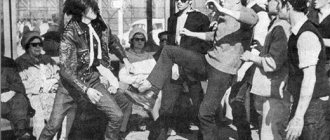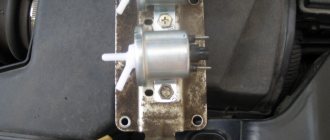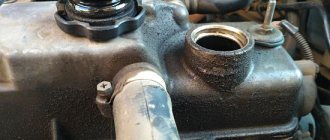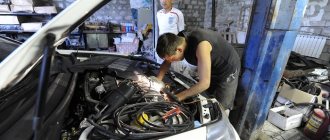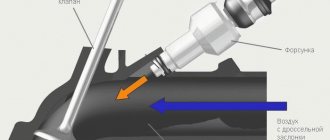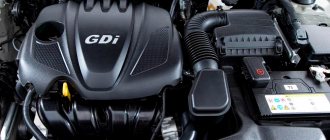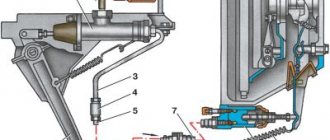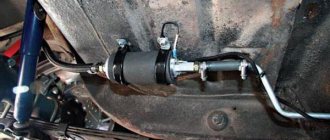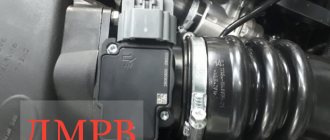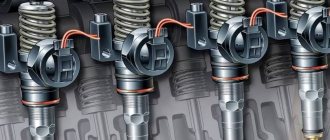A turbocharger is a device that allows you to increase engine power by approximately 30%, without the need to physically increase the volume of the cylinders. Such units are installed on almost all modern cars, regardless of the type of fuel used. Below we will tell you in more detail about the design and operation of a diesel engine turbine, and also outline the disadvantages of this device and the most common breakdowns.
Turbine design and features
The unit consists of two devices - a turbine and a compressor. The task of the first is to convert the energy of exhaust gases, and the second is to supply compressed air to the cylinders. “Impellers” are the main components of this system; they represent two bladed wheels (compressor and turbine).
At its core, a compressor is a pump; its only task is to supply compressed atmospheric air masses to the cylinders. Oxygen is necessary to burn fuel; the more it is supplied, the more the power unit can burn. As a result, this leads to a significant increase in engine power without physically increasing the volume or number of cylinders. The turbocharging system consists of the following components:
- compressor housing;
- bearing housing;
- compressor wheel;
- turbine wheel;
- rotor axis or shaft.
turbine housing;
In a turbocharger, the main element is the rotor, which is protected by a housing and attached to a special axis. Both the rotor itself and the turbine housing are made of heat-resistant alloys - this is necessary due to the fact that they are in constant contact with high-temperature gases.
The rotor and impeller rotate in different directions at high speed - this solution ensures that they are pressed tightly against each other. The operating principle is as follows:
- Exhaust gases enter the exhaust manifold.
- Then - into a special channel located in the supercharger housing, which is made in the shape of a snail.
- In the “snail” the gases are accelerated to high speed and supplied to the rotor.
Thanks to this principle, the rotation of the turbine is ensured. As for the turbocharger axis, it is mounted on special plain bearings and is lubricated by the flow of fluid from the engine compartment. Leakage of lubricant is prevented by the presence of a gasket and O-rings. In addition, mixed and separate flows of exhaust gases and air provide additional sealing. This technological solution does not provide a 100% guarantee that the exhaust will not enter the compressed air, but the system does not require this.
Use of two turbochargers and other turbo parts
Some engines have two turbochargers of different sizes. A small turbocharger revs up faster, thereby reducing acceleration lag, while a large turbocharger provides more boost at high engine speeds.
When air is compressed, it heats up, and when air is heated, it expands. Therefore, the increase in pressure from the turbocharger occurs as a result of heating the air before it enters the engine. In order to increase engine power, it is necessary to let as many air molecules as possible into the cylinder, but it is not necessary to compress the air more.
An air cooler or charge air cooler is an additional device that looks like a radiator, only air flows both inside and outside the cooler. During intake, air flows through a sealed duct into the cooler, with cooler air being drawn from outside through fins by engine cooling fans.
The cooler increases engine power by cooling the compressed air from the compressor before it is supplied to the engine. This means that if the turbocharger compresses air at 7 psi (0.5 bar), the cooler will supply cool air at 7 psi (0.5 bar), which is denser and contains more molecules than the warm air. air. Turbochargers also have an advantage at high altitudes , where air density is lower. Conventional engines will operate weaker at high altitudes because... For each stroke of the piston, the supplied air mass will be less. The power of an engine with a turbocharger will also decrease, but less noticeably, because rarefied air is easier to compress.
In older cars with carburetors, the fuel supply automatically increases in accordance with the increase in air supply. The same thing happens in modern cars. The fuel injection system uses data from the exhaust oxygen sensor to determine the required fuel-to-air ratio, so the system automatically increases fuel delivery when the turbocharger is installed.
When installing a powerful turbocharger on an engine with fuel injection, the system may not provide the required amount of fuel - either the controller software will not allow it, or the injectors and pump will not be able to provide the required supply. In this case, it is necessary to carry out other modifications to maximize the benefits of the turbocharger.
What else is included in the turbocharging system?
The turbine is a complex unit; it took engineers several decades to perfect the system. Only at first glance, the solution to compensate for efficiency losses using exhaust gases seems simple. Even after the creation of the device, it had certain problems for a long time.
For example, it was not possible to solve the problem of turbo lag - a delay after pressing the gas pedal and starting the rotor. The solution was found in the form of using two valves. One of them was used to remove excess air, and the second was intended for exhaust gases. In addition, modern turbines have a modified blade geometry, which seriously distinguishes them from similar devices of the second half of the 20th century.
One more problem can be identified, which was excessive detonation - modern engineers have also successfully dealt with this. The problem was that the temperature in the working sectors of the cylinders increased sharply during air injection, especially in the last stage of the stroke. The solution was found in installing an intercooler (air intercooler).
Intercooler is a device for cooling charge air. It performs two functions at once - it prevents detonation and prevents air density from decreasing. As a result, it was possible to maintain the functionality of the entire system.
It is also worth noting other important components of the turbine.
Control valve. Responsible for maintaining a given pressure level; excess pressure enters the exhaust pipe.
Bypass valve. It is used to remove excess air masses back into the intake pipes - this is necessary to reduce power when there is excess power.
Bleeding valve. If the throttle closes and there is no MAF sensor, the valve will return excess air back to the atmosphere.
Pipes. Sealed pipe sections. Some are used to supply air, the other to supply lubricating oil.
Exhaust manifolds. Must be compatible with turbocharger.
Principle of operation
First you need to understand two terms.
Turbo boost is a condition in which a rapidly rotating rotor increases the air supply to the cylinders, thereby increasing the power of the power unit.
Turbo lag is a short delay that occurs in the operation of the turbine when the amount of fuel supplied increases while the gas pedal is pressed. The delay appears due to the fact that the rotor needs some time until the gases accelerate it.
Turbocharging increases exhaust gas pressure due to more intense engine operation, but at the same time the boost pressure also increases. When critical values are reached, breakdown may occur, and therefore this process must be controlled. Valves are responsible for regulating the pressure, and the membrane and spring monitor the maximum permissible values. When a certain value is reached, the membrane opens a valve to relieve pressure.
How does turbocharging work?
To understand how turbocharging works, you first need to understand the concepts of turbo boost and turbo lag.
Turbo boost is a situation when the rotor, which has picked up speed, increases the flow of air into the cylinders, resulting in an increase in engine power.
Turbojam is a moment of slight delay observed in the operation of the turbine when the amount of incoming fuel increases, which is achieved by pressing the gas pedal. The delay is caused by the time it takes for the rotor to accelerate with gases.
Turbocharging increases the pressure of exhaust gases due to more intense engine operation. At the same time, the boost pressure also increases: this process requires monitoring and adjustment, since when high values are reached, there is a high probability of breakdown. The pressure regulation functions are assigned to the valve; the maximum possible values are controlled by a membrane and a spring with certain stiffness values (when the maximum permissible value is reached, the membrane opens the valve).
The operation of a diesel engine turbine also requires pressure control:
- The compressor releases excess air taken in through a valve to reduce pressure;
- when the pressure of the incoming air reaches the maximum permissible value, the valve releases the gases, and the rotor rotates at the required speed, and the compressor always takes in only the required amount of air.
Operation of a turbocharger on a diesel engine
The work is carried out according to the following scheme:
- The compressor pumps compressed atmospheric air.
- The air mass is mixed with fuel and enters the cylinders.
- The resulting fuel-air mixture ignites, which sets the pistons in motion.
- In parallel with this process, exhaust gases appear and are sent to the exhaust manifold.
- The gases accumulated in the housing significantly increase the speed.
- The rotation passes (along the shaft) to the compressor rotor, it draws in a new portion of air.
It turns out to be an interesting interaction. The rotor rotates faster - more air flows. The more air comes in, the faster the rotor rotates.
Disadvantages of a turbine on a diesel engine
Like any device, the turbine has its own positive characteristics (which were described above) and disadvantages. The disadvantages include, first of all, increased fuel consumption, especially for incorrectly adjusted units. The second disadvantage is sensitivity to fuel quality, which is especially important in Russian conditions. The fact is that low-quality diesel can lead to detonation. Let's note other disadvantages:
- general increase in engine cost;
- increased demands on motor oil;
- oil and filters have to be changed more often (approximately every 5-6 thousand km);
- you need to change the air filter often;
- The turbine life of a diesel engine is significantly lower than that of a gasoline engine (due to higher exhaust temperatures);
- the average resource of the unit is 200-250 thousand km, after which it will require replacement or, at a minimum, major repairs;
- The repair is quite complex, and the average car owner will not be able to carry it out on his own.
However, it is worth noting that the pros still outweigh the cons. Otherwise, turbines would not be so popular.
Turbine Volkswagen Sharan
The engines of this car, equipped with a turbine, have engine displacements equal to: 1.9, 2.0 and 2.5 liters. However, the most successful is the engine with the smallest volume. The 1.9 TDI is characterized by a long service life without the need for major repairs, low maintenance costs and low fuel consumption.
However, there is a drawback: it is too noisy. The design of the turbine is very similar to similar units from competitors. It consists of: the compressor, its input and output shafts, cylinder head valves, and channels for exhaust gas flows. The main difference is the presence of ventilation holes that serve to take air in and out of the turbocharger housing.
Main malfunctions - signs and causes
It’s worth mentioning right away that the main cause of breakdowns is untimely maintenance of the unit; it is recommended to carry it out at least once a year. The next reason is low quality oil or untimely replacement. The third is the entry of foreign objects into the device (for example, small pebbles). Finally, the fourth is the banal wear and tear of individual turbine components, because each equipment has its own service life. Now we will describe the signs that may indicate a malfunction.
Black smoke from the exhaust pipe. The fuel burns in the intercooler or charge line. Most likely there is a malfunction of the control system.
Blue smoke. Perhaps due to a failure in the turbine seal, oil leaks into the combustion chamber.
White smoke. The oil drain line is dirty and will need to be cleaned.
Increased fuel consumption. Air does not reach the compressor.
Increased oil consumption. It is necessary to check the joints of the pipes - the tightness may be broken.
Reduced acceleration dynamics. Most likely, the control system failed, causing a lack of oxygen.
Extraneous whistling, grinding or noise. This could be a change in the rotor clearance, a defect in the housing, an air leak between the engine and the turbine, or contamination of the oil line.
You should always follow the operating rules of the unit - this will reduce the likelihood of breakdowns and extend the life of the device. You should follow a few simple rules:
- monitor the quality of fuel and oil;
- do not forget to change the oil and filters on time;
- start driving only after the engine has warmed up;
- After stopping movement, you need to let the engine idle, and not immediately turn it off.
And, of course, you should undergo regular maintenance.
Turbocharged engine: operating rules
In order for a diesel turbine to operate with maximum efficiency and not fail for as long as possible, you need to adhere to certain rules during the operation of the car:
- adhere to the oil change schedule, which will prevent clogging of the oil line with abrasives;
- use high-quality motor oil that meets the specifications in the engine data sheet;
- do not start immediately after turning on the engine - the engine must be warmed up;
- immediately after stopping movement, do not turn off the engine, allowing it to idle for at least 10 seconds.
What to do if the turbine breaks down
If a malfunction is detected, the first thing to do is carry out diagnostics. And the sooner the better. If you replace a faulty part in time, you will be able to avoid more serious problems. For example, often a car owner does not pay attention to a slight knocking, thinking that it does not matter; as a result, after some time he has to buy a new turbine, although initially a minor repair could have been done.
It should be noted that it is not enough to know how a diesel turbine works - you need to have a perfect understanding of all its components. Only with the appropriate skills, experience and equipment will it be possible to carry out high-quality repairs. That is why we recommend that you do not try to repair the unit yourself (you can only make it worse), but contact. We have been specializing in turbine repair since 1998, and therefore we know everything about them.
5 reasons to contact us:
- High-precision diagnostic equipment is available (Bosch and Delphi stands);
- The staff includes specialists with extensive practical experience in such work.
- Quick repairs within a day without loss of quality.
- We use only original components and repair kits.
- We provide an official guarantee on components and repairs performed.
At the first sign of a defect, contact us. We will determine the cause of the problem and offer an effective, cost-effective way to solve it.
Diesel engine turbine design
A turbocharger is a solution that is installed on both gasoline and virtually every modern diesel car engine. Turbocharged engines are commonly called turbodiesels. This compressor is a kind of air pump that is driven by a turbine. The turbine of a diesel engine is rotated by the energy of exhaust gases.
The main task of the device is to pump air into the cylinders of a diesel internal combustion engine under pressure. The more air enters the combustion chamber, the more diesel fuel the diesel engine can burn. The result is a significant increase in engine power without the need to physically increase the volume of the cylinders.
How a turbine works: video
A turbocharger is a device that allows you to increase engine power by approximately 30%, without the need to physically increase the volume of the cylinders. Such units are installed on almost all modern cars, regardless of the type of fuel used. Below we will tell you in more detail about the design and operation of a diesel engine turbine, and also outline the disadvantages of this device and the most common breakdowns.
Operating principle and design of a diesel turbocharger
The turbocharger of a diesel engine consists of two wheels: turbine and compressor. These wheels can also be called an impeller. The turbine impeller is directly and rigidly connected to the compressor wheel via an axle. The supercharger device can be divided into main components:
- compressor housing (1);
- compressor wheel (2);
- rotor shaft or axis (3);
- turbine housing (4),
- turbine wheel(5);
- bearing housing;
Turbocharger axis
The axis is the central part of the turbocharger and is mounted inside the housing on plain bearings. The axle is lubricated by supplying engine oil from the engine lubrication system. Special O-rings and gaskets are installed on both sides.
These elements prevent excessive oil leaks so that lubricant does not get into the area where the compressor and turbine are located. Oil seals themselves do not provide a complete seal. These solutions are seals that operate due to the pressure difference that occurs during the operation of the turbocharger.
The seals also minimize the breakthrough of air from the compressor and gases from the turbine into the axle housing. It is worth noting that it is not possible to completely eliminate the ingress of exhaust and compressed air from the compressor. The excess is removed through the oil drain line along with the oil and ends up in the diesel engine crankcase.
Lubrication system
The turbocharger shaft is lubricated by the engine lubrication system.
O-rings are installed on the shaft to prevent oil from penetrating into the cavities of the compressor and turbine housings. They also protect the housing from overheating. But tightness is ensured not so much by seals as by the difference in pressure in different parts of the unit. This pressure difference is created by a turbine axis (shaft), which has an uneven diameter.
The special casting shape of the housing in which the shaft is located also helps retain oil.
If the engine does not develop the required power, this may be a symptom of a turbocharger failure. The most common problems are a dirty air filter or loss of airtightness in the intake manifold. In addition to loss of power, they can be diagnosed by the color and amount of smoke coming out of the exhaust pipe, which is unusual for a working car.
Turbo lag and turbo boost
The turbine impeller and compressor wheel are mounted on one common axis. For this reason, a certain dependence is observed, which consists in an increase in the air supply by the compressor only with an increase in turbine speed. Experts distinguish the concept of turbojam (turbolag), which means a delay in the increase in diesel power when the accelerator is sharply pressed.
The turbine impeller is spun by exhaust gases to create effective boost pressure by the turbocharger. Under certain conditions, the turbine can rotate at a very high frequency, which depends on the design features of the device housing and the intensity of the exhaust gas flow.
Self-check of a diesel engine turbocharger. Checking the supercharger without removing it. Presence of oil in the turbine housing, shaft play, impeller.
When and why does it become necessary to adjust the turbocharger actuator. The principle of operation of the device, features and available methods for setting up the wastegate.
What determines the service life of a diesel engine turbocharger? Features and recommendations regarding the operation and repair of turbines with variable geometry.
Turbocharger design, main design elements, turbine selection. Advantages and disadvantages of turbocharged gasoline and diesel engines.
What is a supercharged engine and how does it differ from a naturally aspirated one? The main advantages and disadvantages of turbocharged internal combustion engines. Which motor to choose.
Selecting a mechanical supercharger or turbocharger. Design, main advantages and disadvantages of solutions, installation on an atmospheric tuning engine.
Applications of turbines in Mazda cars
The Japanese manufacturer decided to abandon the production of engines with turbines. Company employees believe that any turbo engine during operation does not achieve the environmental friendliness and fuel economy parameters that are stated in their presentations.
This conclusion comes from the fact that cars are tested under ideal conditions, without taking into account extraneous factors. The release of cars with the SkyActive system has shown that it can consume less fuel than a 1.4 liter turbocharged engine.
These parameters are achieved using a high degree of compression of gasoline atmospheric installations of vehicles. The disadvantage compared to turbocharged units is the low dynamic qualities, but in modern times this is not so relevant.
Why does a diesel turbine practically last forever?
If you compare a turbine on a gasoline engine and take the average mileage of 90,000-120,000 km. and a conventional turbine from a diesel engine with a mileage of 250,000 km, or even more. The operation of a turbine on gasoline and diesel is almost identical. The turbine has a hot part and a cold part. The hot part runs on the energy of the exhaust gases that come from the exhaust manifold and spins this part of the turbine. It is connected by a shaft to a cold compressor wheel which spins up to high speeds and forces air into the engine cylinders. Takes air from the environment. Due to this, we have more air-fuel mixture and the engine power increases.
So why do diesel turbines last longer?
- This is the exhaust temperature.
For gasoline it is 800-900 degrees Celsius, and for diesel it is 500-600 degrees Celsius. (This is on average.) Because the efficiency of a diesel engine is much greater and the energy from the burnt mixture goes into work, while in a gasoline engine it goes into heating. The higher the temperature of the exhaust gases, the more the turbine heats up and the oil that lubricates the bearings (bushings) can burn both in the channels and in the bearings. Therefore, lubrication of the turbine will be much worse and the turbine may completely coke and the oil will stop flowing. Oil not only lubricates but also removes excess heat. Since the exhaust temperature of a gasoline engine is higher, the turbine fails prematurely. But on a diesel engine, the exhaust temperature is lower and the turbine feels better. - Engine speed.
For gasoline, the engine runs at an average of 4000-6000 rpm. min. And diesel is on average 1500-2000 rpm. min. Accordingly, when a gasoline engine exhausts, more exhaust gases pass through the turbine and the turbine spins up faster. A diesel engine has lower revs, the exhaust is not as intense, and the turbine does not spin up as quickly as with gasoline. Fewer revolutions increase the life of the turbine. In a gasoline unit, the turbine develops 100,000-150,000 rpm. min. And diesel performance is much lower. On gasoline, valves are installed to relieve pressure so that the turbine does not rupture. Diesel engines also have them, but diesel engines operate at lower speeds. - Oil.
The base of gasoline and diesel oil is almost the same. But diesel runs on heavy fuel and produces a lot of sulfur during combustion. Sulfur is a solid substance and, when deposited on parts, acts as an abrasive. Therefore, appropriate powerful additives are added to diesel oil to remove sulfur and prevent it from settling on rubbing parts. But gasoline oil does not have such additives. This means that diesel oil lubricates the turbine better, removes oxidation and sulfur, does not burn, and removes heat. - Oil change intervals.
Diesel engines need to change oil more often. Approximately 5000-7000 km. On gasoline 8000-10000 km. This means that the oil on a diesel engine is cleaner and lubricates the turbine much better, and therefore the turbine runs longer on a diesel engine.
